Like many cities across Europe, there is excellent public transport in Athens. The buses, trams and metro around the city are excellent for locals and tourists. Whether you’re planning to see every historical site you can, or you’d prefer to spend your time eating gyros and loukoumades, using the public transport is the most affordable way to get around.
During our week in Athens, we used the metro and buses all the time. From getting off the ferry in Piraeus until we left from Athens airport, we managed to get everywhere we needed to go. If you are planning to stay in the city centre and are only planning to see the main sites, you likely won’t even need transport to get around the city. But you can still use it when you arrive and leave! And if you are staying outside the city or are intending to venture out a bit further, the public transport system will be your best friend.
As budget travellers, public transport systems are always one of the keys to seeing a city without breaking the bank. Even if budget isn’t a consideration, we’d still recommend using the public transport in Athens. The streets are crowded and busy, and parking is notoriously difficult in the city.
We know how difficult it can be to navigate a new public transport system, especially in a country where you may not speak the language. Luckily for you, we’ve had first hand experience using the public transport in Athens as tourists, and we’re here to tell you everything you need to know!
In this post:
- Modes of Transport
- Paying the Fare – Ticket Types
- Cost of Transport
- Finding Timetables and Routes
- Important Things to Know
Once you’ve got a handle on how to use the public transport in Athens, don’t forget to check out our posts about what to do in Athens on a budget, and how to make the most of the Athens combined ticket. We had a fabulous time exploring this beautiful and important city, and we hope you do too!

Modes of Transport
There are three main types of public transport in Athens: trains (metro and suburban railway lines), buses, and trams.
Metro
The Athens metro has existed in some form since 1869. Back then, it was a single line for steam trains. Since then, it has grown to three lines, with a fourth underway that is expected to begin operations around 2030. There are currently 66 stations across the three lines, five of which are interchanges between at least two lines.
The lines have numbers and colours assigned to them, which makes finding your way around the stations a breeze! Line 1 is green and runs from Piraeus to Kifissia, line 2 is red and runs between Anthoupoli and Elliniko, and line 3 is blue, running from Dimotiko Theatro to either Athens International Airport or Doukissis Plakentias. If you are planning to head to or from the airport on the metro, you’ll need a specific airport ticket.
The metro runs every day from 5am until midnight. On Friday and Saturday nights, lines 2 and 3 continue running until 2am.
As may be expected, a lot of the construction of the underground portions of the metro was delayed due to archaeological finds. Archaeologists worked with the engineers and construction workers to ensure that any important artefacts were preserved. As so many artefacts were found through the construction, many stations now have small exhibits of archaeological remains.
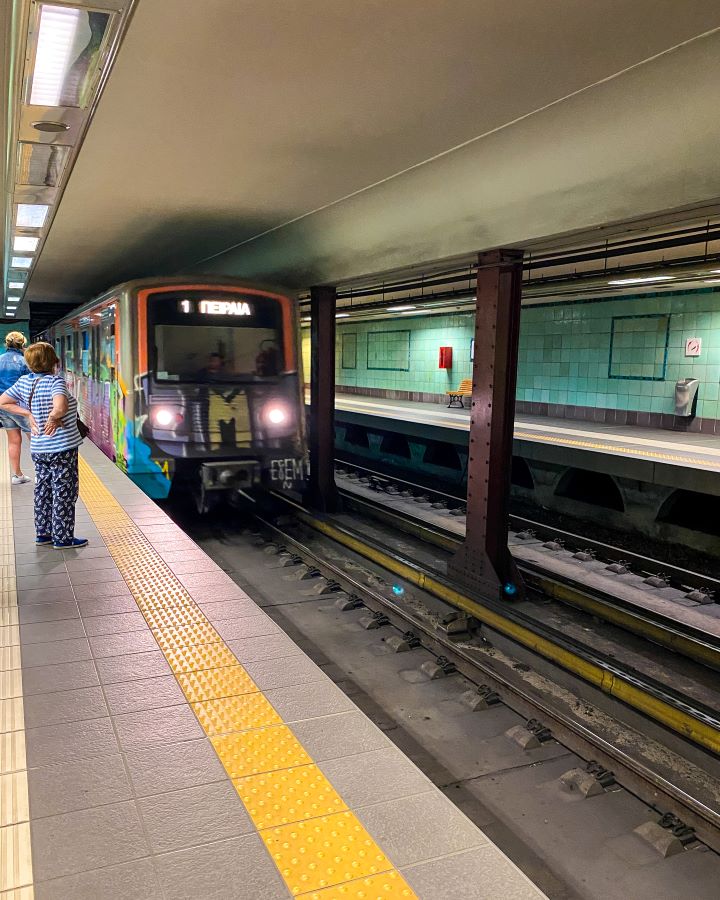
Bus
Athens has both buses and trolleybuses for public transport around the city. The main difference between the two is that trolleybuses are electric and are powered through wires above their routes, while buses are traditional engine vehicles. For the purpose of this blog post, we’re going to group them together as there isn’t any difference in how you catch them.
Buses are definitely the most extensive form of transport around Athens. There are over 60 routes around the city. No matter where it is that you need to get to, there is a good chance that a bus stop is nearby.
Most bus routes run from 5am to midnight, like the metro, but the airport buses run 24 hours a day. Buses to and from the airport do require different tickets than standard buses – we’ll talk more about this below.
Tram
The Athens tram system has existed since the 1880’s, when it was originally powered by horses. It went through various levels of popularity until it was closed in 1960. The tram reopened with five lines in 2004 ahead of the summer Olympics in Athens. This has since been reduced to two lines that connect central Athens to the coast.
The T6 line runs from Syntagma, in the city of Athens, to Pikrodafni, on the coast. The T7 line runs from Piraeus along the coast to Voula. If you are heading to the coast at all, this may be a good option to get you there, especially if you are arriving in Piraeus.
Suburban Railway
There is also a suburban train line in the city. However, this isn’t usually that useful for tourists unless you’re staying outside the city. The one time it may be useful is if you aren’t actually staying in Athens, but heading straight from Piraeus Port to the airport or vice versa. There is a suburban line that travels between the two. The suburban railway runs from 4:30am until 11pm each day.
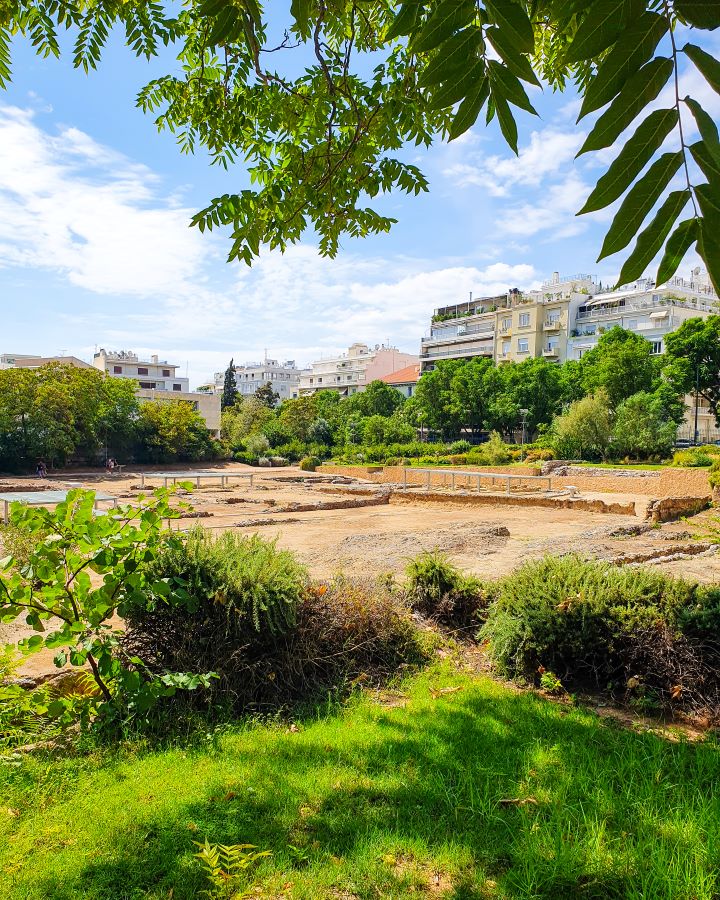
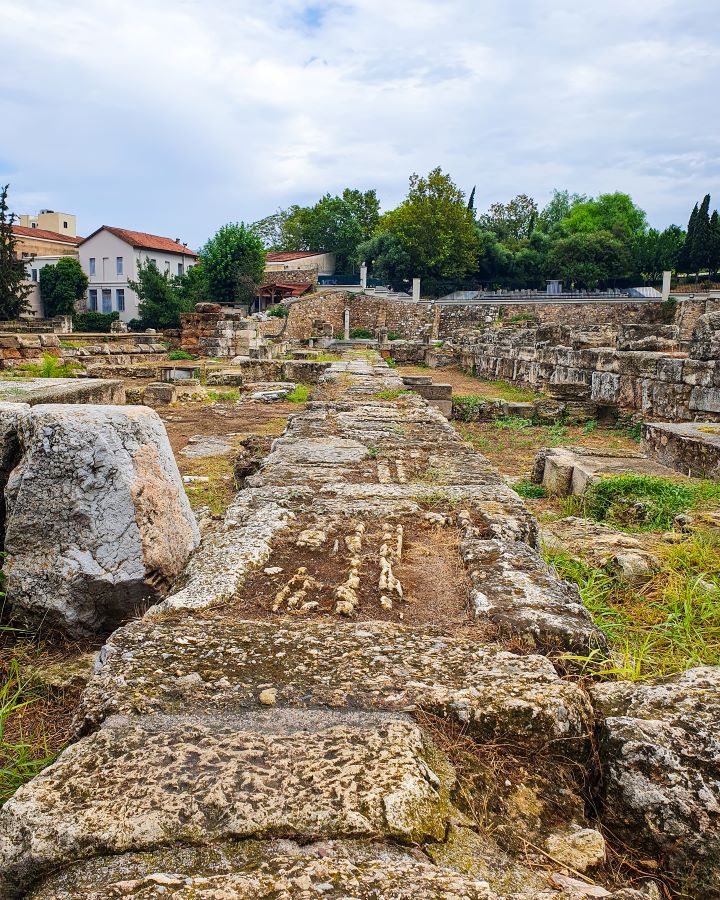
Paying the Fare
One of the more complex aspects of the public transport in Athens is the way you pay the fare. However, you can use the same tickets for all kinds of public transport, and you can transfer for free depending on which fare type you purchase.
While there are multiple options for the kinds of tickets you can buy, you use them the same way. The tickets all contain a small contactless chip, and you tap the card to validate it. On buses and trams, you’ll just tap the card upon entry to the vehicle. At metro stations, you’ll need to tap when you enter and exit the station.
The ticketing system is called Ath.ena, and it comes in three types: one paper ticket and two plastic cards. Let’s go through each type:
Tickets
Tickets are the most simple form of fare payment on public transport in Athens. Ath.ena tickets are available in the following fare types: 90-minute, 24-hour, and 5-day passes, a 3-day tourist tickets, and fares to or from the airport. You can also buy the 90-minute fares in packs of two, five or eleven single tickets.
Tickets can be bought at staffed ticket counters, or from the vending machines in all metro and some tram stations.
Ath.ena tickets are reloadable with all available fare types. However, each fare must expire before you’re able to load anything new.
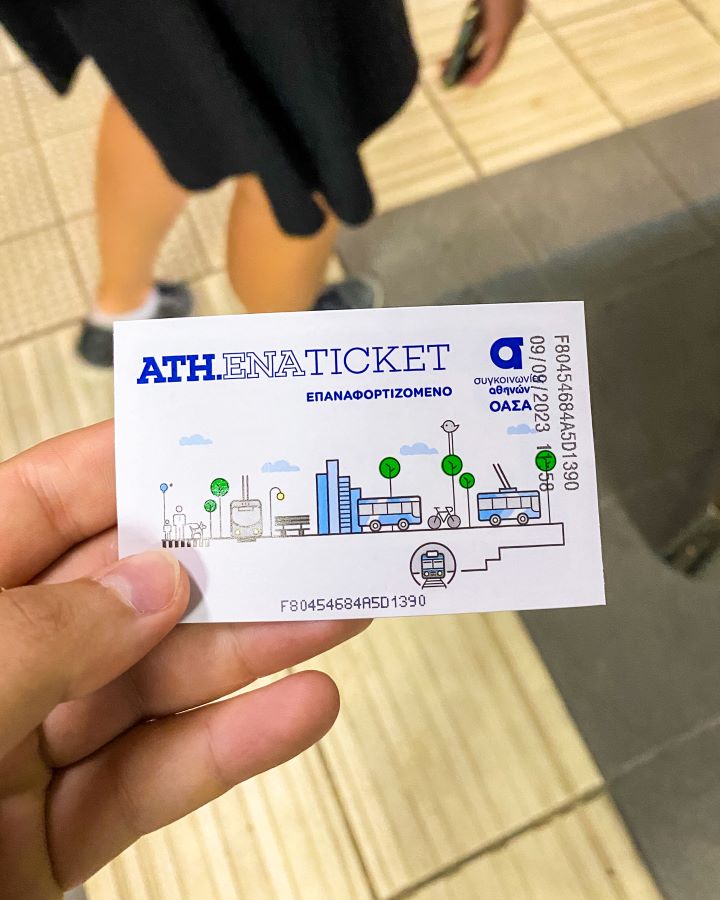
Anonymous Card
Anonymous Ath.ena cards are available from all staffed ticket counters. They are a reusable ticket that can be loaded with the different fare types, as well as monetary value. The fare types available to load on an anonymous card are the same as for tickets. You can also load up to €50 worth of value. You can have up to two products and monetary value on your card at any one time.
Something to be aware of with anonymous cards is that they are not replaceable. If they are lost or damaged, there is nothing that can be done to retrieve the fares or value loaded on the card.
Personalised Card
The personalised card allows you to load fare types or monetary value and have it connected to your identity. This ticket type can be loaded into the Ath.ena card app, or can be topped up online. Personalised cards are also replaceable if something were to happen to them.
The personalised card can be loaded with all the same fares that are available on the anonymous card, as well as 30-day, 90-day, 6-month or 1-year passes.
This option is more aimed at locals or people who will be living in Athens for a longer period of time. However, if you are eligible for free or discounted travel, then a personalised Ath.ena card is the only way you can access the discount.
Where to Buy Tickets
Ath.ena tickets are available for purchase at all metro and some tram stations around the city from automated vending machines. They are also available, along with anonymous cards, at kiosks near some bus stops, and at some stores. Personalised cards are a bit harder as they need your photo and details. You can complete the application for a personalised card here, and then collect it from a ticket office.
For a full list of where you can buy tickets, you can check the Transport for Athens website here.
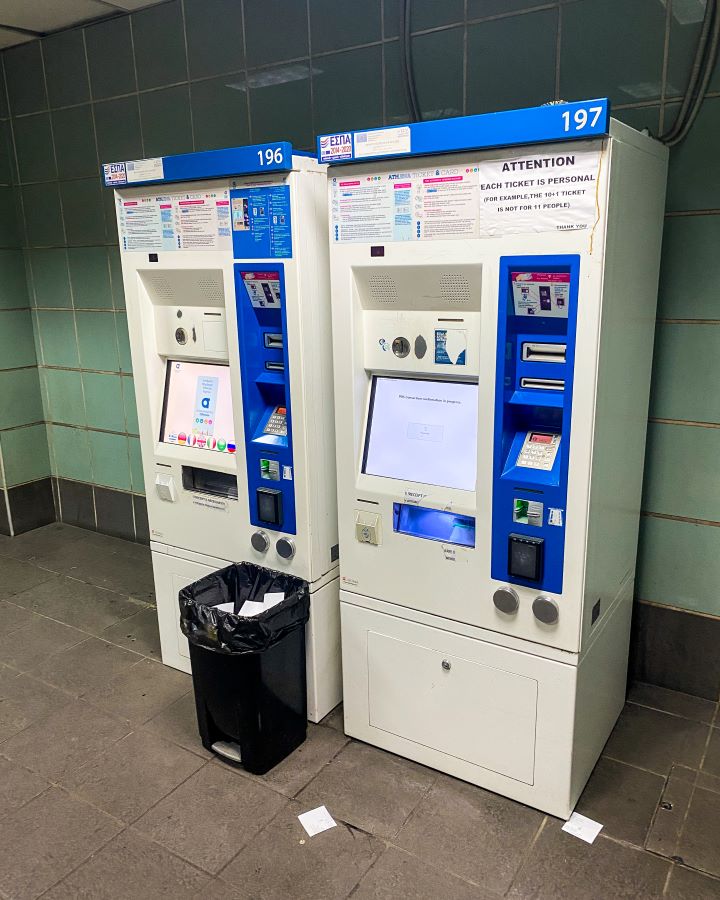
What Should You Use?
We would recommend sticking with the standard tickets for a short stay. If you are wanting to have more than one fare type available at once, then an anonymous card might work better for you, but we found that it wasn’t necessary. The standard tickets are still reloadable, and are readily available. As a tourist, there isn’t much need to get a personalised card unless you’re eligible for a discounted fare.
Cost of Transport
These are the costs for the kinds of fares most tourists would consider purchasing (accurate as of November 2024):
| 90-minute ticket | €1.20 |
| 24-hour ticket | €4.10 |
| 3-day tourist ticket | €20.00 |
| 5-day pass | €8.20 |
| 2x single ticket pack | €2.30 |
| 5x single ticket pack | €5.70 |
| 10+1x single ticket pack | €12.00 |
| Express bus (one-way to or from the airport) | €5.50 |
| Metro airport one-way ticket | €9.00 |
| Metro airport return ticket | €16.00 |
Use the Transport for Athens website for current prices or prices for other ticket types.
Airport Journeys: Please note that the only tickets valid from travel to or from the airport are the 3-day tourist ticket, the express bus ticket or the metro airport tickets. No other ticket is valid for getting to or from the airport.
There are several demographics of people who may be eligible for discounted travel. These include students under 25 years old, people over 65, and children between 7 and 18. Children under the age of 7 travel for free. You can find out more about eligibility for discounts here.
What Should You Use?
Whether you want to buy the 90-minute tickets as you need them or you’d prefer one of the longer passes depends on how long you’ll be staying and how much transport you’ll be catching. We opted for buying 90-minute tickets as we needed them, but the 24-hour, 5-day pass or 3-day tourist pass may be more suitable for you.
If there is any day that you’ll be taking transport four or more times, then the 24-hour ticket is the best value. If you are staying for three days and are arriving and leaving from the airport, then you’ll only need to take four additional journeys during your stay to make the cost of the tourist pass worthwhile. For the 5-day pass, you’d need to take seven journeys. Keep in mind with the 5-day pass that it does not include trips to or from the airport.
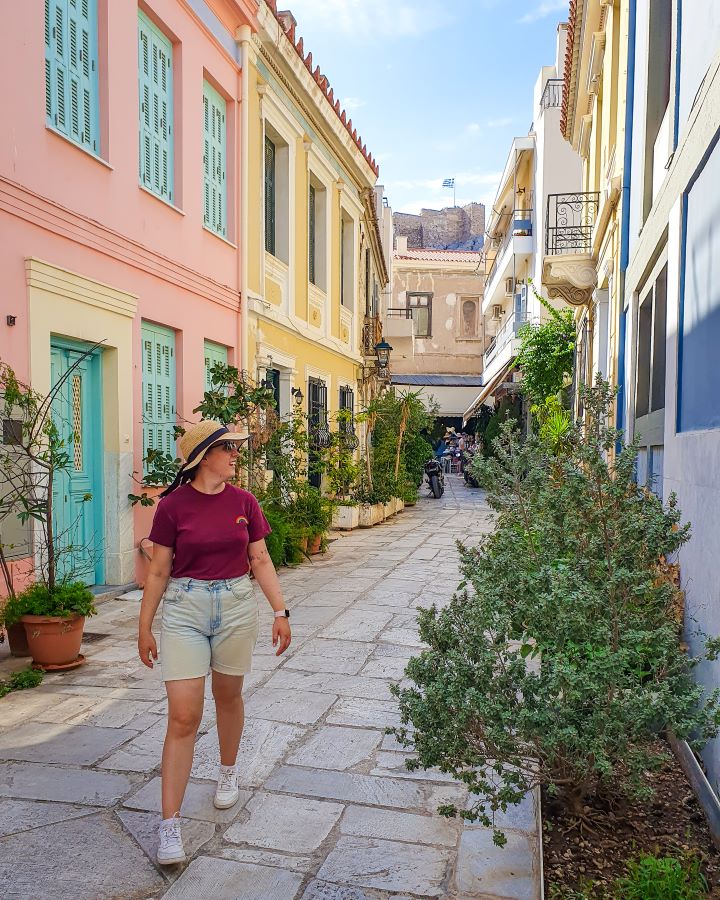
Finding Timetables and Routes
Digital Maps
One of the fantastic things about public transport in Athens is the integration with major digitial apps. Google Maps, Apple Maps and CityMapper all have the ability to find you a route using the public transport in Athens. All bus, metro, tram and suburban railway routes are available.
Transport for Athens
The Transport for Athens website has so much amazing information. It has timetables and routes for a lot of the public transport options, as well as information on where and how to buy tickets, who is eligible for discounts, and any updates and service disruptions.
You can use this page of the Transport for Athens website to find timetable information for specific train lines and bus stops. The Transport for Athens website also has a route finder here, where you can input your start and end destination to find the best route. This will search for you using Google Maps though, so you may as well just jump onto Google to start with.
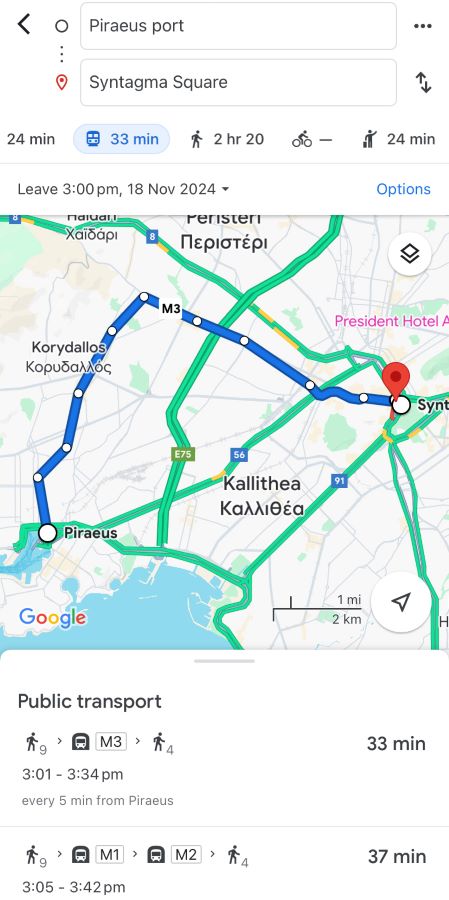
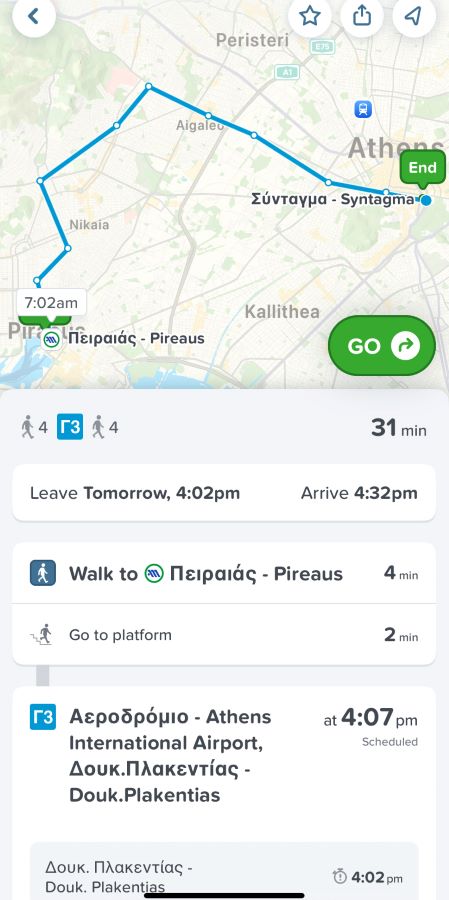
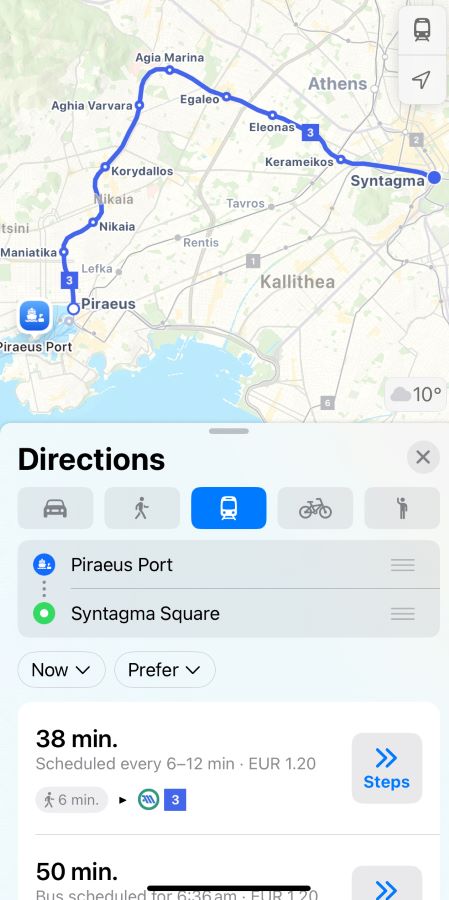
Important Things to Know
There are a few things that you should know before using the public transport in Athens:
- Pickpockets can be common. Like in much of Europe, there is always the risk of pickpockets on public transport in Athens. Always keep your belongings close to your body and pay attention to what is happening around you.
- Accessibility is not bad on buses and metros, but can be difficult on trams. All metro stations have ramps or elevators, so are fully accessible. For assistance boarding or alighting, please talk to station staff who will be able to assist you and arrange for assistance at the end of your journey. Buses in Athens have the ability to be lowered for easier boarding, and most also have ramps for wheelchair access. Trams are a bit harder though, as they cannot be height-adjusted, and they don’t have ramps.
- All buses, trams and metros have airconditioning, but it can get hot in summer and sometimes the airconditioning isn’t sufficient. Be prepared for warm journeys in summer, especially on popular routes that may be crowded.
- We’ve mentioned it a few times, but most tickets are not valid for journeys to or from the airport. Make sure you always have a valid ticket for your intended journey.
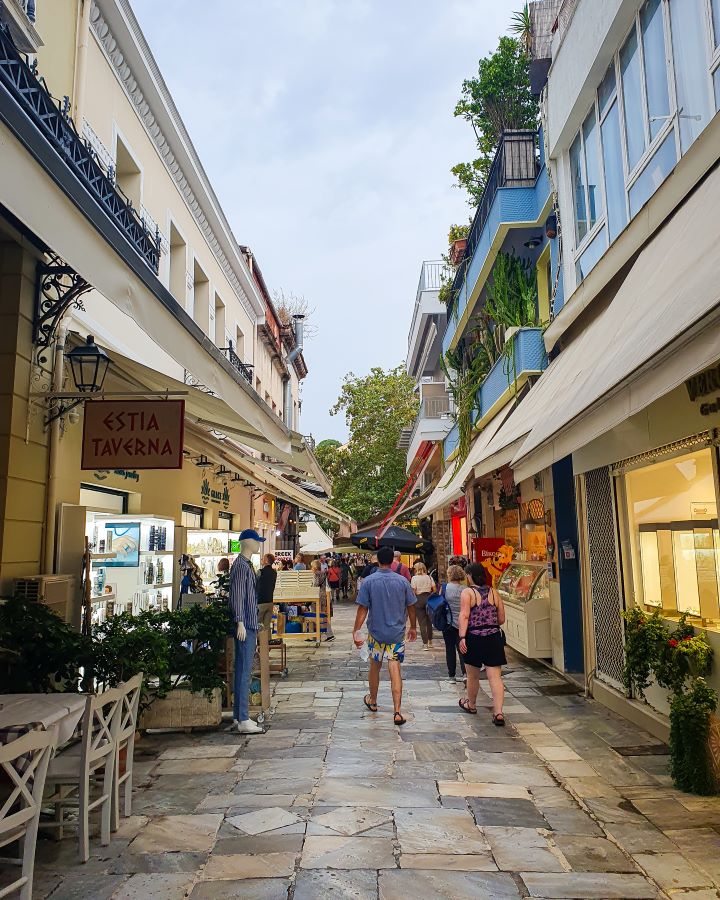

Final Thoughts
Of all the public transport systems we’ve used around the world, the public transport in Athens is one of the easiest to navigate. The ticketing system that can be used across all modes of transport makes a huge difference! That, and the integration with digitial maps, makes it an easy system to learn.
We hope you have a fantastic time in Athens, and that you can save some money by using the public transport system to get around. We always welcome you to leave a comment or reach out to us if you have any questions or anything you’d like to tell us. Happy travels!